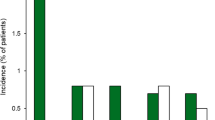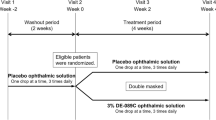Abstract
Diquafosol ophthalmic solution 3 % (Diquas®) is a P2Y2 receptor agonist that promotes tear fluid and mucin secretion and is currently approved in Japan and South Korea for the treatment of dry eye. In randomized, double-blind, multicentre trials in patients with dry eye, significantly greater improvements in fluorescein and rose bengal staining scores were seen with diquafosol ophthalmic solution 3 % than with placebo, and diquafosol ophthalmic solution 3 % was noninferior to sodium hyaluronate ophthalmic solution 0.1 % in terms of the improvement in the fluorescein staining score and more effective than sodium hyaluronate ophthalmic solution 0.1 % in terms of the improvement in the rose bengal staining score. The efficacy of diquafosol ophthalmic solution 3 % in the treatment of dry eye was maintained in the longer term, with improvements also seen in subjective dry eye symptoms, and was also shown in a real-world setting. Diquafosol ophthalmic solution 3 % also demonstrated efficacy in various specific dry eye disorders, including aqueous-deficient dry eye, short tear film break-up time dry eye, obstructive meibomian gland dysfunction, dry eye following laser in situ keratomileusis surgery and dry eye following cataract surgery, as well as in contact lens wearers and visual display terminal users. Diquafosol ophthalmic solution 3 % was generally well tolerated in patients with dry eye, with eye irritation the most commonly reported adverse event. In conclusion, diquafosol ophthalmic solution 3 % is a useful option for the treatment of dry eye.

Similar content being viewed by others
References
The epidemiology of dry eye disease: report of the Epidemiology Subcommittee of the International Dry Eye workshop (2007). Ocul Surf. 2007;5(2):93–107
Foulks GN. Pharmacological management of dry eye in the elderly patient. Drugs Aging. 2008;25(2):105–18.
The definition and classification of dry eye disease: report of the Definition and Classification Subcommittee of the International Dry Eye workshop (2007). Ocul Surf. 2007;5(2):75–92
Skalicky SE, Petsoglou C, Gurbaxani A, et al. New agents for treating dry eye syndrome. Curr Allergy Asthma Rep. 2013;13(3):322–8.
Lau OCF, Samarawickrama C, Skalicky SE. P2Y2 receptor agonists for the treatment of dry eye disease: a review. Clin Ophthalmol. 2014;8:327–34.
Management and therapy of dry eye disease: report of the Management and Therapy Subcommittee of the International Dry Eye workshop (2007). Ocul Surf. 2007;5(2):163–78
Santen. Diquas® (diquafosol soium) ophthalmic solution 3 %: Japanese prescribing information. 2014
Pendergast W, Yerxa BR, Douglass JG 3rd, et al. Synthesis and P2Y receptor activity of a series of uridine dinucleoside 5′-polyphosphates. Bioorg Med Chem Lett. 2001;11(2):157–60.
Fujihara T, Murakami T, Nagano T, et al. INS365 suppresses loss of corneal epithelial integrity by secretion of mucin-like glycoprotein in a rabbit short-term dry eye model. J Ocul Pharmacol Ther. 2002;18(4):363–70.
Li Y, Kuang K, Yerxa B, et al. Rabbit conjunctival epithelium transports fluid, and P2Y22 receptor agonists stimulate Cl− and fluid secretion. Am J Physiol Cell Physiol. 2001;281:C595–602.
Murakami T, Fujihara T, Horibe Y, et al. Diquafosol elicits increases in net Cl− transport through P2Y2 receptor stimulation in rabbit conjunctiva. Ophthalmic Res. 2004;36(2):89–93.
Cowlen MS, Zhang VZ, Warnock L, et al. Localization of ocular P2Y2 receptor gene expression by in situ hybridization. Exp Eye Res. 2003;77(1):77–84.
Jumblatt JE, Jumblatt MM. Regulation of ocular mucin secretion by P2Y2 nucleotide receptors in rabbit and human conjunctiva. Exp Eye Res. 1998;67(3):341–6.
Fujihara T, Murakami T, Fujita H, et al. Improvement of corneal barrier function by the P2Y2 agonist INS365 in a rat dry eye model. Invest Ophthalmol Vis Sci. 2001;42(1):96–100.
Takaoka-Shichijo Y, Shinomiya K, Katsuta O, et al. Stimulatory action of diquafosol tetrasodium on mucin-like glucoprotein secretion in rabbit conjunctival tissues [in Japanese]. Atarashii Ganka. 2011;28(4):543–8.
Takaoka-Shichijo Y, Murakami T, Nakamura M. Stimulatory effect of diquafosol tetrasodium on tear fluid secretion in normal rabbits [in Japanese]. Atarashii Ganka. 2011;28(7):1029–33.
Nakamura M, Imanaka T, Sakamoto A. Diquafosol ophthalmic solution for dry eye treatment. Adv Ther. 2012;29(7):579–89.
Kojima T, Dogru M, Ibrahim OM, et al. The effects of 3 % diquafosol sodium application on the tear functions and ocular surface of the Cu, Zn-superoxide dismutase-1 (Sod1)-knockout mice. Mol Vis. 2014;20:929–38.
Hori Y, Maeno T. Effects of diquafosol ophthalmic solutions and rebamipide ophthalmic suspension on tear fluid volume in normal rabbits [in Japanese]. Atarashii Ganka. 2013;30(7):1007–10.
Sakamoto A, Takaoka-Shichijo Y, Yamashita N, et al. Combined effect of diquafosol tetrasodium and purified sodium hyaluronate ophthalmic solutions on tear fluid volume in normal rabbits [in Japanese]. Atarashii Ganka. 2012;29(8):1141–5.
Takaoka-Shichijo Y, Sakamoto A, Nakamura M. Effect of diquafosol tetrasodium on MUC5AC secretion by rabbit conjunctival tissues [in Japanese]. Atarashii Ganka. 2011;28(2):261–5.
Takaoka-Shichijo Y, Nakamura M. Stimulatory effect of diquafosol tetrasodium on the expression of membrane-binging mucin genes in cultured human corneal epithelial cells [in Japanese]. Atarashii Ganka. 2011;28(3):425–9.
Dota A, Nakamura M. Combined effect of diquafosol tetrasodium and sodium hyaluronate ophthalmic solutions in rat dry eye model [in Japanese]. Atarashii Ganka. 2011;28(10):1477–81.
Hori Y, Shiba T, Maeno T. Comparison of efficacy between diquafosol ophthalmic solutions and rebamipide ophthalmic suspensions in treatment of rat dry eye model [in Japanese]. Atarashii Ganka. 2014;31(1):105–9.
Yokoi N, Kato H, Kinoshita S. Facilitation of tear fluid secretion by 3 % diquafosol ophthalmic solution in normal human eyes. Am J Ophthalmol. 2014;157(1):85–92.
Koh S, Maeda N, Ikeda C, et al. Effect of instillation of eyedrops for dry eye on optical quality. Invest Ophthalmol Vis Sci. 2013;54(7):4927–33.
Shigeyasu C, Hirano S, Akune Y, et al. Diquafosol tetrasodium increases the concentration of mucin-like substances in tears of healthy human subjects. Curr Eye Res. 2014. doi:10.3109/02713683.2014.967871
Matsumoto Y, Ohashi Y, Watanabe H, et al. Efficacy and safety of diquafosol ophthalmic solution in patients with dry eye syndrome: a Japanese phase 2 clinical trial. Ophthalmology. 2012;119(10):1954–60.
Takamura E, Tsubota K, Watanabe H, et al. A randomised, double-masked comparison study of diquafosol versus sodium hyaluronate ophthalmic solutions in dry eye patients. Br J Ophthalmol. 2012;96(10):1310–5.
Yamaguchi M, Tsubota K, Watanabe H, et al. The safety and efficacy of long-term treatment with 3 % diquafosol ophthalmic solution for dry eye [in Japanese]. Atarashii Ganka. 2012;29(4):527–35.
Koh S, Ikeda C, Takai Y, et al. Long-term results of treatment with diquafosol ophthalmic solution for aqueous-deficient dry eye. Jpn J Ophthalmol. 2013;57(5):440–6.
Yamaguchi M, Nishijima T, Shimazaki J, et al. Clinical usefulness of diquafosol for real-world dry eye patients: a prospective, open-label, non-interventional, observational study. Adv Ther. 2014;31(11):1169–81.
Kamiya K, Nakanishi M, Ishii R, et al. Clinical evaluation of the additive effect of diquafosol tetrasodium on sodium hyaluronate monotherapy in patients with dry eye syndrome: a prospective, randomized, multicenter study. Eye. 2012;26(10):1363–8.
Hwang HS, Sung Y-M, Lee WS, et al. Additive effect of preservative-free sodium hyaluronate 0.1 % in treatment of dry eye syndrome with diquafosol 3 % eye drops. Cornea. 2014;33(9):935–41.
Koh S, Maeda N, Ikeda C, et al. Effect of diquafosol ophthalmic solution on the optical quality of the eyes in patients with aqueous-deficient dry eye. Acta Ophthalmol (Copenh). 2014;92(8):e671–5.
Shimazaki-Den S, Iseda H, Dogru M, et al. Effects of diquafosol sodium eye drops on tear film stability in short BUT type of dry eye. Cornea. 2013;32(8):1120–5.
Kaido M, Uchino M, Kojima T, et al. Effects of diquafosol tetrasodium administration on visual function in short break-up time dry eye. J Ocul Pharmacol Ther. 2013;29(6):595–603.
Jung HH, Kang YS, Sung MS, et al. Clinical efficacy of topical 3 % diquafosol tetrasodium in short tear film break-up time dry eye [in Korean]. J Korean Ophthalmol Soc. 2015;56(3):339–44.
Kobashi H, Kamiya K, Igarashi A, et al. Intraocular scattering after instillation of diquafosol ophthalmic solution. Optom Vis Sci. 2014; doi:10.1097/OPX.0000000000000490.
Arita R, Suehiro J, Haraguchi T, et al. Topical diquafosol for patients with obstructive meibomian gland dysfunction. Br J Ophthalmol. 2013;97(6):725–9.
Toda I, Ide T, Fukumoto T, et al. Combination therapy with diquafosol tetrasodium and sodium hyaluronate in patients with dry eye after laser in situ keratomileusis. Am J Ophthalmol. 2014;157(3):616–22.
Masuda A, Mori Y, Nejima R. Efficacy of long-term treatment with diquafosol sodium for dry eye due to laser in situ keratomileusis [in Japanese]. Atarashii Ganka. 2013;30(2):249–53.
Mori Y, Nejima R, Masuda A, et al. Effect of diquafosol tetrasodium eye drop for persistent dry eye after laser in situ keratomileusis. Cornea. 2014;33(7):659–62.
Takeshita T. Effect of diquafosol sodium ophthalmic solution for dry eye after cataract surgery [in Japanese]. Rinsho Ganka. 2013;67(3):327–30.
Watanabe K. Efficacy and safety of combined 3 % diquafosol sodium and 0.3 % purified sodium hyaluronate for treatment of dry eye in wearers of frequent-replacement of one-day disposable soft contact lenses [in Japanese]. Nihon Contact Lens Gakkaishi. 2014;56:121–5.
Uchino Y, Tsubota K. Effect of switching treatment from existing therapy to 3 % diquafosol sodium eyedrops for dry eye in VDT users [in Japanese]. Atarashii Gankka. 2013;30(6):871–4.
Gong L, Sun X, Ma Z, et al. A randomised, parallel-group comparison study of diquafosol ophthalmic solution in patients with dry eye in China and Singapore. Br J Ophthalmol. 2015; doi:10.1136/bjophthalmol-2014-306084.
Takashima Y, Goya K, Matsuo M. Effect of switching from hyaluronate to diquafosol ophthalmic solution for mild dry eye [in Japanese]. Rinsho Ganka. 2013;67(6):929–33.
Tauber J, Davitt WF, Bokosky JE, et al. Double-masked, placebo-controlled safety and efficacy trial of diquafosol tetrasodium (INS365) ophthalmic solution for the treatment of dry eye. Cornea. 2004;23(8):784–92.
Disclosure
The preparation of this review was not supported by any external funding. During the peer review process, the manufacturer of the agent under review was offered an opportunity to comment on this article. Changes resulting from comments received were made by the author on the basis of scientific and editorial merit. Gillian Keating is a salaried employee of Adis/Springer.
Author information
Authors and Affiliations
Corresponding author
Additional information
The manuscript was reviewed by: Y. Hori, Department of Ophthalmology, Toho University Omori Medical Center, Tokyo, Japan; S. Koh, Department of Ophthalmology, Osaka University Graduate School of Medicine, Osaka, Japan; Y. Mori, Miyata Eye Hospital, Miyakonojo, Japan; M. Yamada, Department of Ophthalmology, Kyorin University School of Medicine, Tokyo, Japan.
Rights and permissions
About this article
Cite this article
Keating, G.M. Diquafosol Ophthalmic Solution 3 %: A Review of Its Use in Dry Eye. Drugs 75, 911–922 (2015). https://doi.org/10.1007/s40265-015-0409-7
Published:
Issue Date:
DOI: https://doi.org/10.1007/s40265-015-0409-7




